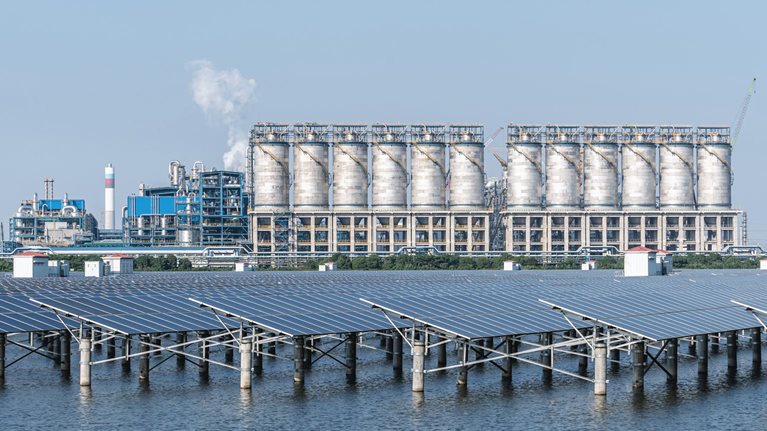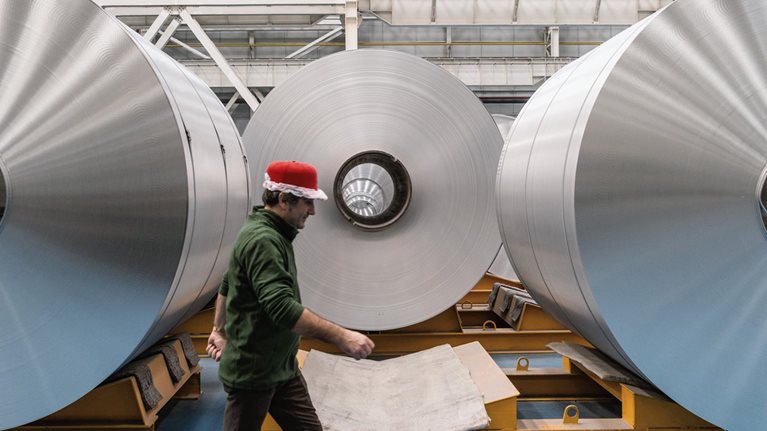In recent years, regulation and growing consumer demand for low-emission vehicles have turbocharged the race to drive down tailpipe emissions. Now, with significant gains made to reduce carbon emissions—and an electric-vehicle (EV) future upon us—car manufacturers need to look beyond the tailpipe to deliver greener cars at competitive cost and a reduced carbon footprint.
By turning their attention back to the design process and scrutinizing the end-to-end manufacturing value chain, industry players have an opportunity to capture the dual benefit of carbon and cost savings.
However, with demand for low-carbon materials growing from a range of industries and competitors—and global supply constrained—automotive firms will need to act with speed to secure their low-carbon supply chains.
This article explores materials and production processes as the next frontier for carbon emission reductions, and the steps industry players can take now to develop environmentally friendly cars at a lower per-unit cost.
Cost and carbon pressures continue to mount
As EV technology advances and global markets prepare for the phasing out of internal-combustion-engine (ICE) vehicles, OEMs face a squeeze on their profit margins. EVs are more expensive to manufacture than petrol or diesel engine cars and require substantial R&D and capital expenditure investments. Not surprisingly, control over the cost of each EV sold is now a core component of OEM business models.
At the same time, since mid-2020, car manufacturers’ decarbonization targets have become increasingly ambitious. OEMs are making bold commitments beyond their scope 1 and 2 emissions, and some of the leading global manufacturers are setting stretching targets to reduce emissions across the entire product value chain.
The electrification of cars alone will not automatically lead to net zero. Battery-electric vehicles (BEVs) can have up to twice the amount of production emissions compared with ICE vehicles—driven by the carbon intensity of batteries and high number of electronic components. High-emission materials such as aluminum and battery-active materials drive up emissions, making value chain decarbonization essential for securing the net-positive CO2 benefits of EVs (Exhibit 1).

Would you like to learn more about our Environmentally Sustainable Operations?
While decarbonization beyond the tailpipe can be a key differentiator within the automotive industry, the global supply of low-carbon materials is currently lower than demand. Supply is likely to be squeezed further as more industries scramble to secure low-carbon value chains in the coming years. Firms will need to act fast to get ahead of the competition for supply.
Pursuing the dual mission of cost and carbon savings
Adapting the industry standard design-to-value (DTV) process to consider all value at stake, instead of cost alone, can help companies secure the greatest total value and most attractive economies over the entire product life cycle.
DTV combines deep insights from three key areas: what consumers value in products; competitive insights into how other companies design offerings to meet consumer needs; and supplier insights into new technologies and the cost to manufacture products. The result is greater ability to translate high-level strategy into design choices for products and services as well as the underlying processes along the supply chain. The resulting insights can lead to decisions to simplify the product design through using less material, reduce the specifications where possible, or investigate smarter design solutions.
By adding a sustainability lens to this fact-based, multidimensional approach, the reimagined dual-mission DTV and carbon methodology could enable automotive-industry firms to uncover opportunities for decarbonization across the manufacturing value chain.
From this methodology, four key principles emerge to achieve cost and carbon savings in the automotive sector. As cost reduction is already standard practice for many companies, the focus here is on the carbon reduction aspect of the approach.
Create transparency on the CO2 baseline. With car manufacturers facing increasing scrutiny on the total carbon footprint of their vehicles, understanding the CO2 baseline of a vehicle is the critical first step. This includes a detailed breakdown of CO2 for each product along the value chain.
To offer full transparency into the process, the baseline includes CO2 emissions along the primary material production processes—for example, mining, smelting, and casting for aluminum—as well as the component production processes, such as process consumables and production machinery. In rim production, for example, smelting the raw material accounts for 64 percent of the carbon emitted, while only 14 percent of the carbon comes from the activities of tier-1 suppliers (Exhibit 2).

Crucially, manufacturers cannot rely solely on suppliers to provide this detail and may need to develop the capability internally to generate the level of transparency required to arrive at an accurate CO2 baseline.
Identify and evaluate CO2 levers. Once carbon-intensive components and processes are understood, a number of levers can be applied to address the different production processes that emit CO2. Levers include alternative energy sources, circularity to decrease waste, design shifts to reduce the amount of raw material required or material used—for example, changing from magnesium to recycled plastic—and energy efficiency.
In the rim production example, the most promising levers focus on smelting aluminum with renewable energy and increasing the share of recycled aluminum. But additional levers focus on tier-1 suppliers, such as reducing energy use during the painting process. Examples from Asian suppliers show that several of these levers, including the shift to a different aluminum supplier with lower emission levels, could be achievable at the same or even lower cost, while at the same time reducing emissions by more than 50 percent.
To decide on the right cost and CO2 levers to pursue, the saving potential of carbon reduction needs to be factored in to enable fact-based decision making. Including a carbon price into the accounting helps to determine holistically if a cost reduction that causes an increase of carbon—or a carbon decrease that causes an increase in cost—is the right thing to do. Focusing solely on cost and carbon reduction in equal measure limits the potential for big steps toward zero-carbon products (Exhibit 3).

Define the implementation strategy. Next, the identified levers can be evaluated and prioritized regarding both cost and CO2 emission impacts, as well as other relevant implications such as quality and availability of supply. The CO2 effect of each product can be understood by drawing on raw-material analysis, regional-specific emission factors, process steps, and internal and external logistics, alongside the parts price and investment effort.
Based on these insights, implementation strategies can follow a number of different routes. Components can be redesigned through technical changes, or OEMs can look to collaborate with existing suppliers on changes to processes or materials. Where these routes prove unfeasible, an overall switch in material strategy or supplier may be needed.
The key areas of focus for implementation include how to handle supplier negotiations and how to implement any technical changes affecting manufacturers. A close working relationship between manufacturers and suppliers can help encourage a shift to alternative energy sources and make sure supplier operations run as efficiently as possible.
Where a technical change is required, car manufacturers may need to create a plan to redesign and validate potential tool changes with additional cost savings in mind. Establishing the feasibility of acting on every supply change can illuminate what is technically possible within an organization and how these changes will affect the way car manufacturers approach and understand potential and past suppliers.
Implement alternative technical design or negotiate different material sources. Collaboration with suppliers and R&D are key enablers of both the commercial and technical aspects of the implementation strategy. To this end, it is helpful to develop targeted strategies for negotiating cost and quality improvements with suppliers and to help suppliers decarbonize their own supply chains, for a win–win scenario. Implementation on the technical side requires significant preparation regarding the detailed value chain and material input analysis, as well as feasibility evaluation, and testing with R&D.

Outsprinting the energy crisis
Four key insights to steer a dual-mission strategy
The dual-mission DTV and carbon approach has been applied with success across numerous sectors, giving rise to four key insights that can help shape the dual-mission challenge.
The time to act is now. Several opportunities for cost-efficient decarbonization will be available only during a short window: the supply of materials needed for minimizing emissions faces increasing demand but not yet on the level forecasted. This will not be the case for much longer. Future carbon taxes might further increase the pressure to act.
It is possible to reduce cost and CO2 at the same time. Acting now means there is an opportunity to capture cost and carbon opportunities together. For example, OEMs working directly with raw-material suppliers have successfully decreased the CO2 emissions of aluminum components by 50 percent—and at the same time closed cost gaps.
Significant reductions can be achieved in short time frames. A global automaker used this dual-mission approach to identify up to 5 percent cost and 20 percent carbon reduction opportunities for an in-production EV, with an implementation time of less than two years. For next-generation vehicles, the opportunity to decarbonize products and achieve cost efficiency has proven even larger based on a greater degree of freedom in design and supplier choices.
A broad set of capabilities is needed. Capabilities need to be built broadly in the organization to successfully execute the dual-mission program. This includes supply chain transparency—for example, analyzing the carbon footprint of different suppliers, understanding the levers, including implementation effort and time versus carbon reduction potential, design-for-sustainability thinking, and the upskilling of the procurement team on how to work with suppliers.
As EVs begin to dominate our roads and the focus moves away from tailpipe emissions to total carbon footprint, calls for carbon emission transparency across the product life cycle and end-to-end value chain will grow louder.
With increasing pressure from regulatory bodies as well as customers, the automotive industry needs actionable steps to shift toward more sustainable methods of production.
By acting now—and adopting a dual-mission approach—companies have a window of opportunity to not only reduce material- and production-related emissions but also save costs and address tightened profit margins.
While the technical knowledge and internal capabilities required to unlock these savings are not insubstantial, manufacturers may need to mobilize the necessary resources to pursue this route if they are to stay a step ahead of the pack.


